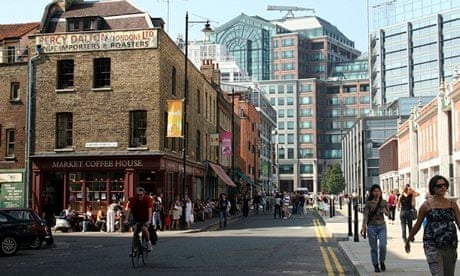Everybody loves the East End of London. Its trendy bars and street markets, the foggy myth that oozes from films, books and TV dramas like Ripper Street and Whitechapel attract tourists and new residents in their tens of thousands. But worried local people say the character of the area, already one of the most densely populated in England, is at risk of being destroyed by a "powerful lobby of rich vested interests" including developers, expanding City firms and the mayor, Boris Johnson.
Last month, more than 200 campaigners and local people attended the inaugural meeting of the East End Preservation Society where speakers including art historian and broadcaster Dan Cruickshank said the high-rise development boom represented a "collapse of local democracy" that is fast stripping away the historical streetscape, heritage and scale of the area and creating a legacy of social problems.
The society was the idea of a group including Cruickshank, Will Palin, the former secretary of Save Britain's Heritage, and the influential Gentle Author whose daily Spitalfields Life blog raises concerns about threats to the local area. Cruickshank says the society hopes to be a coherent vioce to protect the area from "creeping and ghastly greed". At the launch Cruickshank and Palin recalled a list of historic casualties including the western half of Spitalfields market, Bishopsgate goods yard, the "spectacular" Gothic-style Columbia market and Mother Levy's, the last surviving 18th-century Jewish maternity hospital.
Once a local focal point, Gardener's Corner in Aldgate – the spot where thousands of working-class Londoners stopped Mosley's Blackshirts during the Battle of Cable Street in 1936 – has been erased and replaced with a series of huge luxury developments.
Cruickshank lives in Spitalfields and took part in a famous 1970s sit-in which saved some 18th-century Huguenot silk-weavers' houses from demolition. He outlines plans to "largely demolish the sound and handsome" 1920s London Fruit and Wool Exchange in Spitalfields for a scheme that includes no housing, and entails the destruction of the popular local pub, The Gun, and the eradication of 17th century Dorset Street.
"The site could hardly be more sensitive, located in a conservation area, and opposite Nicholas Hawksmoor's Christ Church, one of most moving historic buildings in London," he says. "The scheme was originally rejected by Tower Hamlets council, but the mayor of London, acting as judge and jury, overturned the local authority's decision."
Cruickshank says an alternative local scheme, which kept the existing buildings and street pattern, and proposed housing and local employment, "was dismissed out of hand". "This story represents a collapse of local democracy, and a cynical disregard of local people and opinion."
On the Bishopsgate goods yard site, developers want to build six massive towers ranging from 28 to 55 storeys. Former pop star, Matt Johnson of The The, a born and bred East Ender and Shoreditch resident has said the number of licensed premises had soared from around 15 in the 1990s to over 300, creating an area that was "Magaluf by night and a Klondike goldrush [for developers] by day".
Campaigner Saif Osmani, describing plans for a massive development behind Whitechapel Road market, featuring another huge tower, said the plans, which run to over 100 pages, contained no mention of the largely Bangladeshi population living there. He says drastic action has to be taken to protect the area and gave the example of his role in the successful community campaign that saved Queen's market in nearby Newham from demolition.
But some worry that this campaign is simply hand-wringing by the middle classes. East End-born writer Alan Gilbey, who lives off Brick Lane, says: "There was a lot of talk [at the meeting] of Spitalfields and Shoreditch, but not a lot about less glamorous parts. There wasn't much about people – except for those who were worried about developments affecting 'the light in their studios'. There wasn't much about what the East End means to many people or the sense of displacement many feel. At the moment, battling East End mums are opposing the redevelopment of Shadwell park. I hope the preservation folk will chain themselves to bulldozers along with the mums."
Palin says that while many in the preservation society are experts in art, history and architecture, he wants it to be democratic. "We want everyone to get involved, but they will have the help of people who understand how the planning and conservation system works."
Tower Hamlets mayor Lutfur Rahman agrees that democracy is being undermined. "I am concerned that decisions are being made at regional levels that undermine our ability to deliver local benefits and do what's best for our borough," he says. He gave the recent example of London mayor, Boris Johnson, overturning the council's decision to refuse permission for a luxury tower in Canary Wharf, "allowing this extravagant development to proceed despite its impact on local amenities and in exchange for minimal benefit for local residents".
In response to the concerns rasied by the preservation society, Sir Edward Lister, the Greater London Authority's deputy mayor for planning, said in a statement that, given the immediate priority to create over half a million new jobs and new housing for over a million people, it was not possible to "impose some kind of freeze on the skyline and suspend the capital in stasis… The work requires a strategic approach to protecting the city's skyline, with detailed policies in the London Plan ensuring that the right buildings are in the right place, that tall buildings sit well with their surroundings and that prominent buildings embody the highest standards."
He added: "The key issue in any discussion of London's skyline is whether a building makes a positive contribution to London's urban realm, protecting the things we value about our city, while helping us meet the challenges of growth and ensuring the continued prosperity of London and Londoners."

Comments (…)
Sign in or create your Guardian account to join the discussion